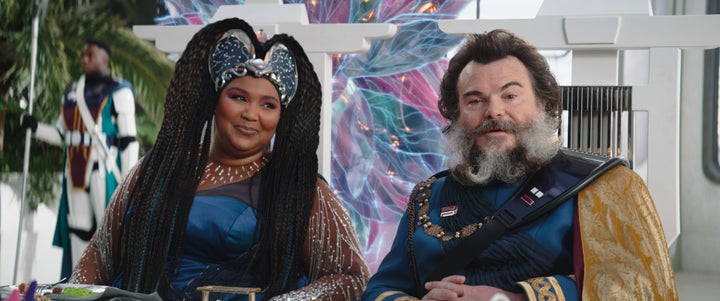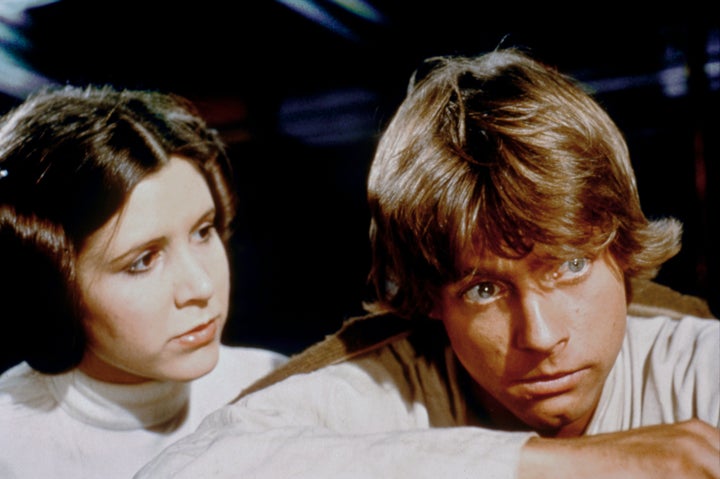
Hollywood has an aversion to fat characters — on screen, they’re typically punchlines, nonexistent or, worse yet, actors in fat suits. In “Star Wars,” plus-size humans have been largely absent, though fat aliens have appeared in the franchise for decades, inevitably evoking insults and cruel jokes about the fat community. But are things finally beginning to change in the galaxy far, far away?
In “Guns for Hire,” the sixth episode in the latest season of “The Mandalorian,” Din Djarin (Pedro Pascal) and Bo-Katan Kryze (Katee Sackhoff) travel to Plazir-15, a planet governed by the Duchess and her husband, Captain Bombardier. While guest stars and cameos are a dime a dozen in franchise properties (especially Disney ones), what’s notable about the Duchess and Bombardier is that they’re played by plus-size actors: Lizzo and Jack Black.
And later in the episode, Djarin and Kryze interact with a lab tech portrayed by Jen Kober, another plus-size actor. This is a rare instance of fat characters, played by fat actors, being represented as people and not offensive tropes in “Star Wars.”
Before this, whenever a fat character showed up in the franchise, they were usually a grotesque and slovenly alien. Jabba the Hutt — whose name has become a taunt for real fat people in the real world — appeared in the original film trilogy for the sole purpose of repulsion. (Even Jabba apparently knows that’s how he’s viewed, as Karen Traviss writes in the novelization of the “The Clone Wars” film.) Jabba is a giant, slimy slug, but he’s also a vile gangster who tries to kill Han Solo (Harrison Ford), enslaves people like Princess Leia (Carrie Fisher), eats live creatures, and slobbers all over himself. He is disgusting, and we rightfully cheer when Leia strangles him to death.
The problem isn’t that Jabba exists, but that he is the trilogy’s representation of an unconventionally shaped character and is such a horrifying villain. But the fat-shaming didn’t stop with Jabba; in subsequent “Star Wars” properties on both the big and small screens, fat aliens are treated with similar disdain.
“The fat-shaming didn’t stop with Jabba; in subsequent 'Star Wars' properties on both the big and small screens, fat aliens are treated with similar disdain.”
Across animated and live-action fare, “Star Wars” portrays fat characters as evil gluttons. Unkar Plutt, Orn Free Taa, Azmorigan, the Twins and, more recently, Mokko are all fat, and they’re all the absolute worst.
In “The Force Awakens,” Plutt is a ruthless junk boss on the planet Jakku, hoarding supplies and food rations while scavengers like Rey (Daisy Ridley) scrounge around for their next meal. Plutt is literally referred to as “The Blobfish” in the franchise — an obvious dig at his size and features. To top it all, Plutt is played by the decidedly nonfat actor Simon Pegg in a fat suit.
Taa, who appeared in the prequel trilogy and in the series “The Clone Wars,” is a senator for the planet Ryloth. While his people starve and cling to survival during the titular Clone Wars conflicts, Taa is busy lining his pockets and gorging on feasts to satiate his enormous appetite.
Azmorigan, a recurring villain on the animated show “Rebels,” is a criminal leader so lazy that he doesn’t walk — he avoids it when he can and uses a flat trolley to get around in one episode. Like Taa, he loves food, and he eats it with gusto. His character design was even based on an early version of Jabba.
In the second season of the series “The Bad Batch,” which aired earlier this year, viewers meet Mokko, a gang boss who supervises a group of child laborers. He gifts the top-earning kid their own bowl of slop, while the rest must fight over a single shared bowl, each getting only spoonfuls to survive on. Meanwhile, Mokko hides in his office, stuffing himself from a table full of food.
Notice a pattern here?
In “Star Wars,” characters only get fat by being lazy and eating an unnatural amount of food. That’s a commonly held belief about plus-size people in the real world too, and the franchise repeatedly doubling down on it is deeply problematic.
Even Boss Nass, the leader of the Gungan High Council introduced in “The Phantom Menace,” is larger than other members of his species, playing into the “fat cat” trope that the franchise loves. Still, he’s not an out-and-out bad guy.
Dexter “Dex” Jettster, Obi-Wan Kenobi’s friend on the planet Coruscant, is another prequel trilogy character who is fat but not a villain. However, Jettster’s appearance, with a heavily stained, too-short shirt and visible belly, embodies unfortunate tropes about fat people being slovenly.
The Twins from the “Book of Boba Fett” series are spared any food-related scenes, but look at how lazy these hutts are — despite their enormous sizes, some poor, slender bipeds must carry them on a platform. We’re once again reminded that those who are fat in “Star Wars,” and by extension the real world, are inconsiderate of others (that is, thin people) and force them to suffer.
Though no character explicitly calls the Twins fat, it’s obvious that they look different because of their size. Tie this in with their behavior, and it’s clear that the franchise is showcasing a disturbing trope. Adding fat characters to the story is great, but the way that “Star Wars” often portrays them epitomizes biased notions of fat people in the real world. These are more like caricatures than three-dimensional characters.
Hollywood, of course, doesn’t care. Films like “The Whale” and “The Batman” were just released in 2022 and included actors wearing fat suits. “The Whale” even won an Academy Award for Best Makeup and Hairstyling for its fat suit.
Such on-screen portrayals affect how people view the world — as a place where certain sizes shouldn’t exist, or can only exist if they entail suffering. The long-standing hate and derision of larger people in entertainment have made society so much worse for plus-size individuals in the real world.
This is evident behind the scenes in Hollywood as well, including the production of “Star Wars.”
As Leia, Fisher had to pose perfectly straight when filming the infamous gold bikini scenes in “Return of the Jedi” because “no creases were allowed.” And when she was asked to reprise her role in “The Force Awakens,” the studio sent a personal trainer to weigh her and get rid of her unhealthy food. Luke Skywalker actor Mark Hamill apparently faced a similar issue and had to hit the gym. Would these actors be unable to portray their beloved characters with a little extra fat on their bodies?
Studio intervention is bad enough, but stars have to contend with fatphobic fans too. When Temuera Morrison returned to the franchise in Season 2 of “The Mandalorian,” he was body-shamed online despite being straight-size, and he later looked decidedly trimmer while leading “The Book of Boba Fett.” It’s not like Morrison carried less gravitas as a grizzled and portly version of the former bounty hunter, but apparently Disney took fans’ fatphobic criticism to heart and turned Fett into a superfit crime lord.

After many years of offering insulting representations of fatness, “Star Wars” now has multiple characters who are a breath of fresh air, like Shep Hazard. In “The Bad Batch,” Hazard is portrayed as a tall, portly gentleman who is unwaveringly kind but also wise, and he looks out for his people. As a refugee on the planet Pabu, he is empathetic toward the show’s Bad Batch squad and their forced nomadic existence.
And then, most recently, there are the Duchess and Bombardier. Though the couple are introduced in “The Mandalorian” hosting a feast, the focus is not on them eating. All they want is help from Djarin and Kryze to protect their people. The two have created a utopian world where nobody has to work; they can enjoy the arts and participate in politics, while droids take care of the rest.
Unlike the Plutts and Jabbas of the franchise, the Duchess and her husband are generous, and they care for others. Grogu, the character popularly known as “Baby Yoda,” immediately loves the Duchess, so that’s a seal of approval right there. And seeing humans like the unnamed lab tech, as well as other fat background characters, demonstrates that people on Plazir-15 live happily, irrespective of their shape or size.
With characters like these, maybe there’s hope that “Star Wars” is changing. We probably can’t expect a major shift, especially since the cast members announced so far for upcoming properties like “Ahsoka” and “The Acolyte” all have conventional Hollywood body types.
But, at the very least, “The Mandalorian” has showed us in just one episode how the franchise could be more inclusive of different bodies, if only it would try.
CORRECTION: A previous version of this story incorrectly said the film “Everything Everywhere All at Once” included a character in a fat suit.
